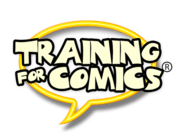DON’T WRITE YOUR STORY IN ONE GO: THE ART OF CREATIVE PLANNING
Have you ever felt tempted to sit at your desk and start writing your comic story from beginning to end without stopping? While enthusiasm is admirable, this approach can lead you down a path full of creative obstacles. In this article, we’ll explore why writing “in one go” can be counterproductive and offer you valuable strategies to develop your narrative more effectively and satisfactorily.
From the importance of taking strategic breaks to the power of prior planning, you’ll discover how to shape your ideas in an organized and creative way. Get ready to transform your writing process and take your stories to the next level. Keep reading and unlock the potential of your creativity!
The Continuous Writing Trap: Avoiding Confusion and Disorientation
Imagine this: you sit at your drawing table, pencil in hand, determined to create your comic masterpiece in one go. You start with the first panel and set out not to stop until you reach the last page. Sounds ambitious, right? Unfortunately, this approach often leads to a creative dead end.
As you progress, you’re likely to find yourself lost, not knowing how to continue. Worse yet, you might feel the urge to redo parts you’ve already created because better ideas came to you. This cycle of moving forward and backward can be frustrating and counterproductive.
To avoid falling into this trap, it’s crucial to adopt a more structured approach. Click here to discover methods that will help you organize your ideas effectively. With the right tools, you’ll be able to shape your narrative coherently and avoid the confusion that arises from trying to create everything at once.

The Power of Taking Notes: Capturing the Essence of Your Story
Before diving into the actual writing, it’s essential that you ask yourself key questions about your story. What type of narrative are you creating? How much do you know about its beginning and ending? These answers shouldn’t just float in your mind; they need to be captured in a tangible form.
Take a piece of paper, open a document on your computer, or use an app on your phone. The important thing is that you start writing down everything you know about your story. This documentation process can take various forms:
- Lists of key events
- Tables with character traits
- Paragraphs describing settings
- Graphs of relationships between characters
- Quick sketches of important scenes
The goal is to empty your mind of all those ideas you’ve been accumulating. Remember, ideas occupy mental space, and by releasing them onto paper (or digitally), you create room for new inspirations to emerge.
Once you’ve written down your initial ideas, take some time to reread them. It’s surprising how this simple act can trigger a cascade of new ideas. Write down these new inspirations as well. With this expanded mental map, you’ll be much better prepared to start working on developing your story.
Want to improve your skills in visually capturing ideas? Explore more here and discover techniques that will help you express your thoughts more effectively, facilitating the process of creating your comic.

The Importance of Knowing When to Take a Break: Recharging Your Creativity
In the world of art and creation, there’s a mistaken belief that constant productivity is the key to success. Perhaps you’ve experienced those moments when you immerse yourself in your script, clearly visualizing each panel, filling pages and pages with dialogues and actions of your characters. But is it really enough? When does it become “too much”?
It’s easy to fall into a cycle of worries while writing:
- Is what I’m writing of good quality?
- Should I rewrite some parts?
- How do I know when I’ve really finished?
These concerns can increase as you accelerate your writing pace, until you inevitably reach a point of intellectual and emotional exhaustion. You find yourself exhausted, empty of energy and purpose. But is it necessary to reach this extreme?
The answer is a resounding no. It’s crucial to establish schedules or even entire days where you forbid yourself from writing or working on your story. This is as important as having moments dedicated exclusively to writing. Use these breaks for other activities that can nurture your creativity indirectly:
- Practice drawing techniques
- Read comics or graphic novels that inspire you
- Go for a walk and observe the world around you
- Visit an art gallery or museum
- Chat with friends about topics unrelated to your project
You’ll be surprised how much a story can progress when you stop actively writing it. When you return to your manuscript after a well-deserved break, you’ll find a new perspective and renewed energy to continue.
Enter here to discover exercises that will stimulate your creativity during your breaks. These activities will help keep your mind agile and ready for when you return to your main project.

Writing Before Writing: Exploring the Universe of Your Characters
Have you ever considered writing scenes that won’t be part of your final story? If the answer is no, you may not be completely ready to dive into the main narrative yet. Think of it as training: how could you run a marathon without having practiced shorter distances first?
This “pre-writing” exercise is invaluable for getting to know your characters in depth. Here are some ideas to get you started:
- Write a scene where your villain performs an everyday task, like going to the bakery.
- Describe the first time your protagonist saw fireworks.
- Imagine what a day in the life of your secondary character would be like if they had an unexpected superpower.
By exploring these hypothetical situations, you free your mind from the constraints of the main plot. Don’t worry about dramatic conflict or chronology; simply let your characters act and react in these new contexts.
This process will allow you to:
- Discover hidden facets of your characters
- Better understand their motivations and reactions
- Develop unique and authentic voices for each one
- Generate ideas that could enrich your main story
When the time finally comes to integrate these characters into your main narrative, you’ll feel much more prepared to allow them to act in an organic and convincing manner. The freedom you give yourself in these exercises directly translates into the depth and authenticity of your characters within the story.
Enhance your ability to create memorable characters. Access exclusive resources here that will help you bring your creations to life more effectively and excitingly.

Plan Before Acting: Structuring Your Narrative
Once you’ve explored your characters and have a general idea of your story, it’s time to structure your narrative. This process is like putting together a puzzle: you have all the pieces, now you need to find out how they fit together perfectly.
Start by identifying the key points of your story:
- The hook that engages the reader
- The plot twists that maintain interest
- The climax that brings tension to its peak
- The resolution that satisfies and closes the narrative
With these elements in mind, you can start grouping and ungrouping the events of your story. If you already have a clear beginning and end, you’re in an excellent position to work on the middle development.
Some useful techniques for this stage include:
- Creating major stages: Group the events of your story into 2-3 large sections. This will give you a macro view of the structure.
- Breaking down into scenes: Divide each major stage into individual scenes. Ask yourself what purpose each scene serves in the overall story.
- Analyzing transitions: Examine how one scene leads to the next. Are the transitions smooth and logical?
- Identifying narrative gaps: Look for areas where the story might need more development or explanation.
Don’t be afraid if there are aspects you’re still unclear about. Leave those blank spaces and continue working on the parts you do understand. Often, solutions to these gaps will naturally emerge as you develop other sections of the story.
Elevate your narrative to the next level. Discover advanced structuring tools here that will help you create more cohesive and engaging stories in your comics.

From Planning to Creation: The Moment to Bring Your Story to Life
After following all these preparatory steps, you’ll be much better equipped to begin the process of writing and drawing your comic. It’s important to recognize that all the preliminary work you’ve done—from character exploration to narrative structuring—is already a valuable form of creative writing.
Now that you have a solid foundation, consider these final tips for making the leap to the concrete creation of your comic:
- Creative flexibility: Keep an open mind to changes and adjustments in your original plan. Sometimes, the best ideas emerge during the creation process.
- Work pace: Establish a regular schedule to work on your comic, but be flexible. Some days will be more productive than others, and that’s okay.
- Feedback: Don’t be afraid to share your work in progress with other trusted artists or readers. Their perspectives can offer valuable insights for improvement.
- Balance between planning and spontaneity: Although planning is crucial, leave room for in-the-moment inspiration. If a brilliant idea comes to you while drawing, don’t hesitate to explore it.
Remember, if at any point during this process you get the urge to draw a specific page of your comic, do it! These bursts of creativity can be incredibly motivating and often result in some of the best parts of your work.
Ready to bring your ideas to paper? Access resources here that will enhance your creative process and help you transform your concepts into vibrant comic pages.
Conclusion: The Art of Creating with Purpose
Throughout this article, we’ve explored why writing a story “in one go” can be counterproductive and how a more structured approach can enhance your creativity and the quality of your work. Let’s recap the key points we’ve covered:
- The importance of avoiding confusion and disorientation through proper planning
- The power of writing down and organizing your ideas before starting to write
- The need to take strategic breaks to recharge your creativity
- The value of “writing before writing” to develop deeper characters
- The effectiveness of planning and structuring your narrative before diving into creation
Adopting these strategies will not only help you avoid the dreaded writer’s block but will also enrich your creative process, allowing you to develop more complex and satisfying stories. Remember, every artist has their own method, and it’s important to find the balance between planning and spontaneity that works best for you.
Don’t be afraid to experiment with different techniques and adapt these tips to your personal work style. The key is to keep your passion for storytelling alive while developing skills that allow you to express your ideas more effectively.
Now that you have these tools at your disposal, it’s time to get to work. Take your ideas, organize them, explore your characters, structure your narrative, and when you’re ready, bring your story to life page by page, panel by panel.
Ready to take your comic art to the next level? Discover additional resources here and begin your journey towards creating truly memorable stories.
Remember, every great comic started as an idea in its creator’s mind. With dedication, planning, and creativity, you too can transform your ideas into works that captivate and inspire readers. The world is waiting for your unique story!



